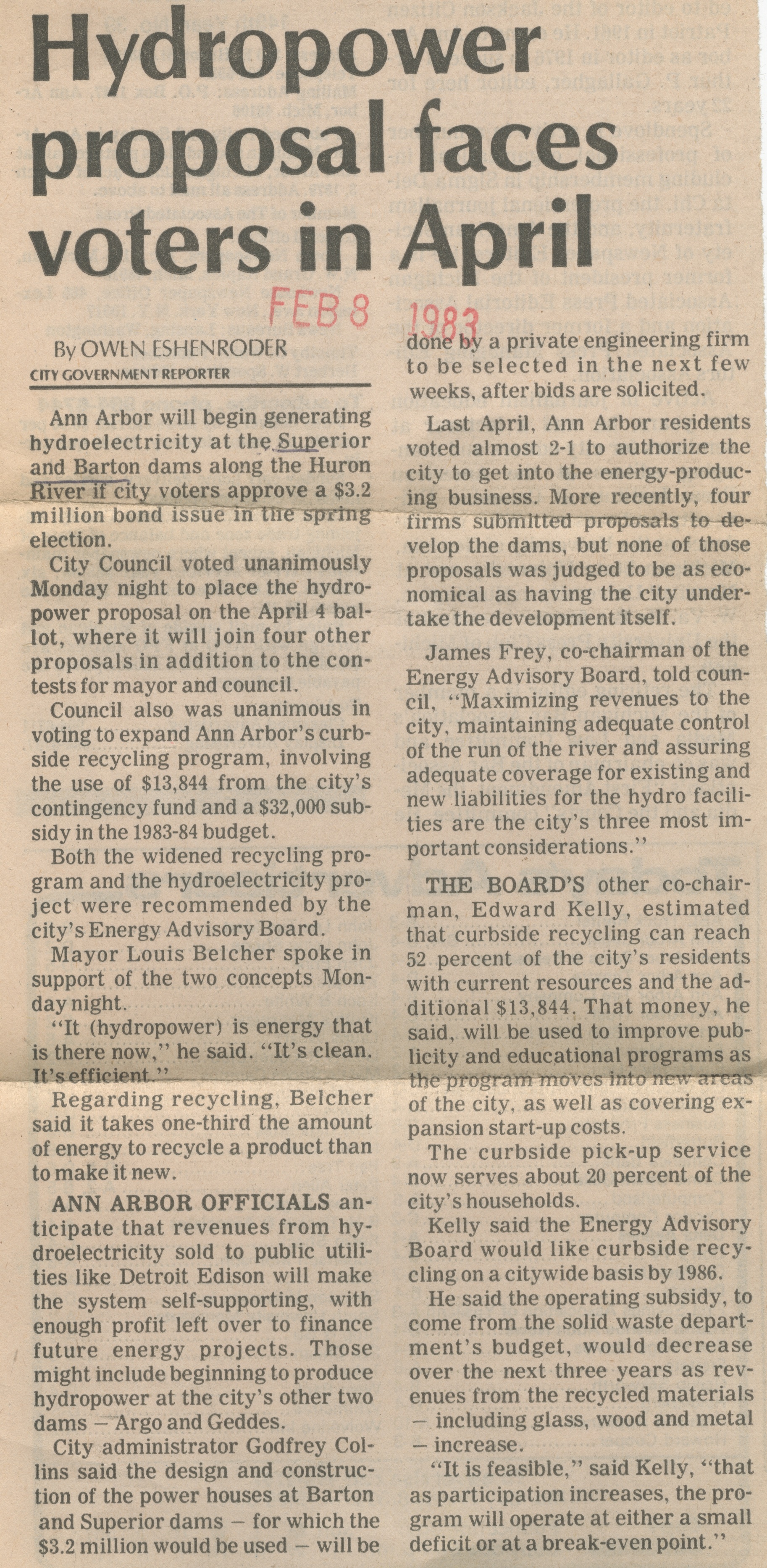Hydropower Proposal Faces Voters In April

Hydropower
By OWEN ESHENRODER
CITY GOVERNMENT REPORTER
Ann Arbor will begin generating hydroelectricity at the Superior and Barton dams along the Huron River if city voters approve a $3.2 million bond issue m tlitf spring election.
City Council voted unanimously Monday night to place the hydro-power proposal on the April 4 ballot, where it will join four other proposals in addition to the contests for mayor and council.
Council also was unanimous in voting to expand Ann Arbor’s curb-side recycling program, involving the use of $13,844 from the city’s contingency fund and a $32,000 subsidy in the 1983-84 budget.
Both the widened recycling program and the hydroelectricity project were recommended by the city’s Energy Advisory Board.
Mayor Louis Belcher spoke in support of the two concepts Monday night.
“It (hydropower) is energy that is there now," he said. “It’s clean.
Regarding recycling, Belcher said it takes one-third the amount of energy to recycle a product than to make it new.
ANN ARBOR OFFICIALS anticipate that revenues from hydroelectricity sold to public utilities like Detroit Edison will make the system self-supporting, with enough profit left over to finance future energy projects. Those might include beginning to produce hydropower at the city’s other two dams - Argo and Geddes.
City administrator Godfrey Collins said the design and construction of the power houses at Barton and Superior dams - for which the $3.2 million would be used - will be
done by a private engineering firm to be selected in the next few weeks, after bids are solicited.
Last April, Ann Arbor residents voted almost 2-1 to authorize the city to get into the energy-producing business. More recently, four firms submitted proposals to develop the dams, but none of those proposals was judged to be as economical as having the city undertake the development itself.
James Frey, co-chairman of the Energy Advisory Board, told council. "Maximizing revenues to the city, maintaining adequate control of the run of the river and assuring adequate coverage for existing and new liabilities for the hydro facilities are the city’s three most important considerations.”
THE BOARD’S other co-chairman. Edward Kelly, estimated that curbside recycling can reach 52 percent of the city's residents with current resources and the additional 513,844. That money, he said, will be used to improve publicity and educational programs moves into new areas of the city, as well as covering expansion start-up costs.
The curbside pick-up service now serves about 20 percent of the city's households.
Kelly said the Energy Advisory Board would like curbside recycling on a citywide basis by 1986.
He said the operating subsidy, to come from the solid waste department’s budget, would decrease over the next three years as revenues from the recycled materials
- including glass, wood and metal
— increase.
“It is feasible,” said Kelly, “that as participation increases, the program will operate at either a small deficit or at a break-even point.”
Article
Subjects
Owen Eshenroder
Water Supply
Taxation - Ann Arbor & Washtenaw County
Superior Dam
Recycling Services
Public Utilities
Millages
Hydroelectric Power
Huron River
Floods
Elections - Ann Arbor
Detroit Edison Company
Dams
Barton Pond
Barton Dam
Ann Arbor Energy Advisory Board
Ann Arbor City Council
Ann Arbor - City Government Departments
Old News
Ann Arbor News
Louis Belcher
James Frey
Godfrey Collins
Edward Kelly